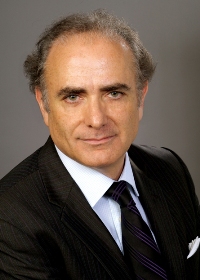Air Canada's new chief executive Calin Rovinescu, abruptly ushered in on 1 April,faces a multitude of challenges to avoid taking the carrier into its second formal restructuring this decade. But pulling the bankruptcy lever to stave off the carrier's mounting pension payments and significant debt obligations is not a foregone conclusion.
The sudden resignation of chief executive Montie Brewer and the placement of formerexecutive Rovinescu at the helm of Air Canada has triggered a wave of speculation that Rovinescu aims to stage a repeat performance of the carrier's previous restructuring. Rovinescu was a key figure during the carrier'sreorganisation under Robert Milton during 2003-04 under the Canadian version of Chapter 11 known as the Companies' Credit Arrangement Act. Heservedaschief restructuring officer.
 |
|---|
Air Canada's welldocumented challenges include a C$3.2 billion ($2.7 billion) pension deficit as of 1 January and its required 2009 pension contribution could range from C$150-C$410 million, depending on a range of factors including pension reform legislation under consideration by the Canadian government.
Along with that potentially looming payment, Raymond James analyst Ben Cherniavsky estimates Air Canada faces the maturing of roughly C$660 million in debt during the next six-to-12 months.
Obligations in one of the carrier's credit card processing agreements also require a minimum cash balance of C$900 million per month to prevent payment holdbacks, rising to C$1.3 billion later this year. Its cash balances at2008 year-end stood at just over C$1 billion.
The carrier's mounting debt payments and scurrying to keep cash at certain levels is occurring against the backdrop of contract expirations with the majority of its unionised workforce. They are eager to gain traction from C$1 billion in concessions negotiated during its last restructuring.
Rovinescu has no illusions about the obstacles he faces in his work to get Air Canada on solid financial footing. "This is not an easy task in a situation such as ours," he tells employees. "We not only have a global recession that has impacted travel more severely than SARS or 9/11, but we also face a vigorous domestic competitor whose cost structure is significantly lower."
Different Position
History points to many carriers seeking bankruptcy protection in far less dramatic circumstances. But while analysts acknowledge some similarities exist in Air Canada's situation prior to its previous restructuring, they also believe some distinctions are present today.
"Whereas a broken business model and inflated balance sheet caused the airline to go bankrupt in 2003, today's immediate threats are more directly and immediately related to the global credit crunch and the impact it has had on Air Canada's cash flow statement," says Cherniavsky of Raymond James.
Similarly CIBC World Markets warns not to directly link the return of Rovinescu with a CCAA filing. Ithighlights that Air Canada has appointed a chief executive with a "particular skill set" who is most capable of overcoming the carrier's challenges outside of bankruptcy.
Rovinescu's first priority should entail working with unions to mitigate any potential strike action, says Versant Partners analyst Cameron Doerksen . He says any work disruption would be "a significant problem for Air Canada financially".
Doerksen also believes the Star Alliance carrier's efforts to get pension relief in labour negotiations should parallel its lobbying of the government to ease those requirements.
But Rovinescu is likely to find little support for pension reform among labour groups as the Canadian Auto Workers says slashing the pension plan was a major demand from Rovinescu during the carrier's previous restructuring and has already made clear its position. Shortly after Rovinescu's appointment the union fired a warning shot, saying its members "were not willing to forfeit their retirement income then, nor will we be when we get back to the negotiating table over the next few months."
Second Chance
Furthermore CAW contends that suggesting "Rovinescu and others deserve a second chance at 'fixing' Air Canada is disturbing", after selling off profitable sections of the company resulted in a weakened carrier.
After CAW issued those statements, Air Canada swiftly highlighted that Rovinescu has had regular communications with employees, whose "reaction has been positive" particularly about his declaration that he has no plans to shrink the carrier to profitability through dramatic route and fleet cuts.
Along with crafting a strategy for its contract talks, Air Canada should also take the current opportunity to refine certain areas of its business model, suggests Doerksen of Versant Partners. He says that while there is no indication that Air Canada plans to be anything less than a global full-service carrier, in his opinion it would be wise for the carrier to cede market share in certain domestic markets where its costs are uncompetitive.
Aside from any decisions Air Canada makes about its domestic market share its rival WestJet continues to step up its competitive pressure. Citing the C$5 billion domestic market in Canada WestJet chief financial officer Vito Culmone highlights the carrier's plans to grow its present 36% share of the market to 45%-50% by 2013. Culmore believes WestJet's cost advantage allows the carrier to tap markets even in today's weak pricing environment and still achieve a profit.
As it struggles with a strengthening rival, a cash crunch and labour issues,for now no oneis volunteering to predict the ultimate outcome of what analyst Cherniavsky characterises as a "multiple unknown variables". If pushed to speculate, "we would say that the possibility of Air Canada getting through this current predicament is about 50:50 at bestregardless of which way the penny drops on the question of bankruptcy protection. 2009 is going to be year of enormous uncertainty and considerable duress for Air Canada".
Read our cover interview from 2006 with former Air Canada boss Robert Milton here
Source: Airline Business























